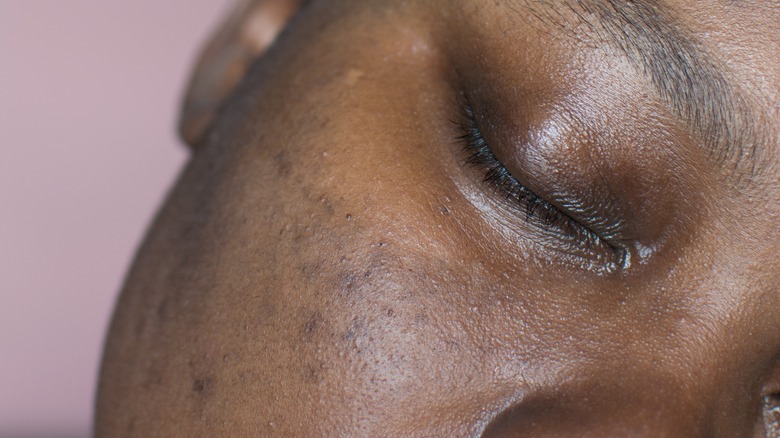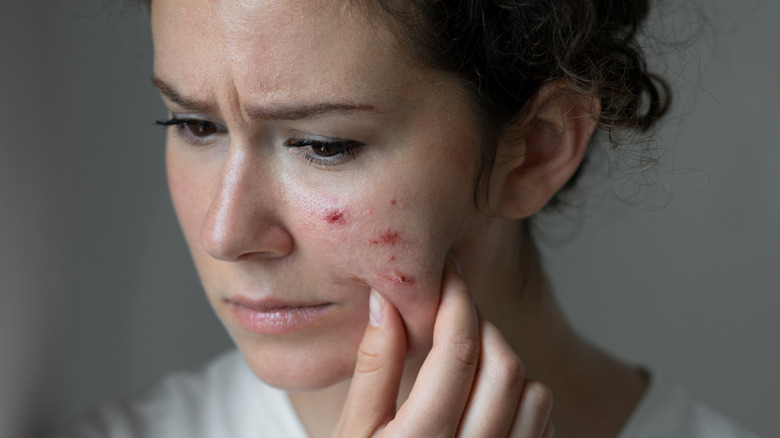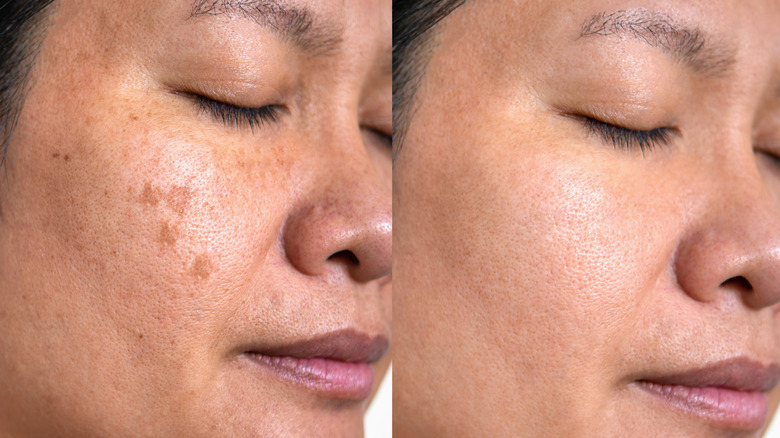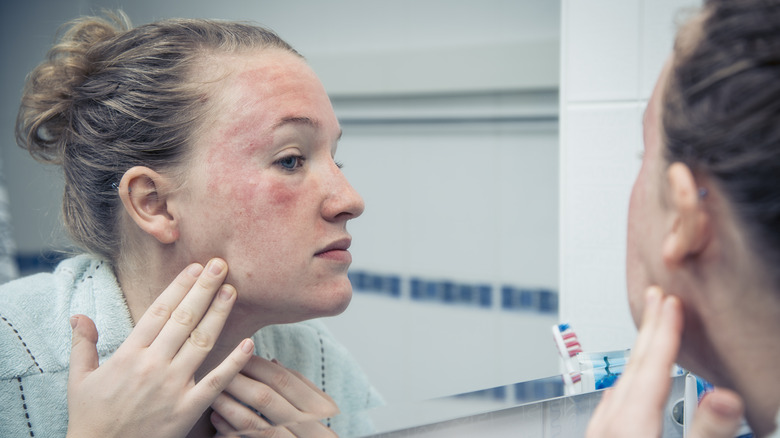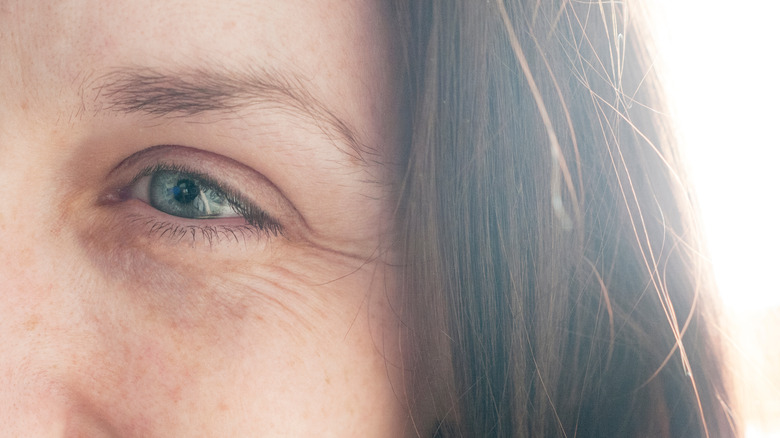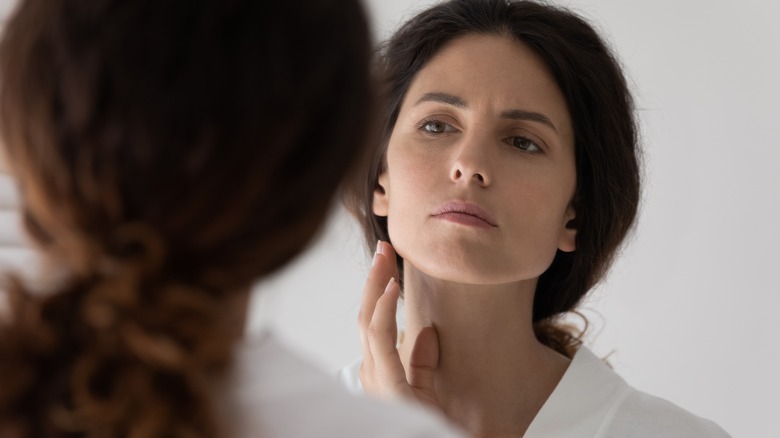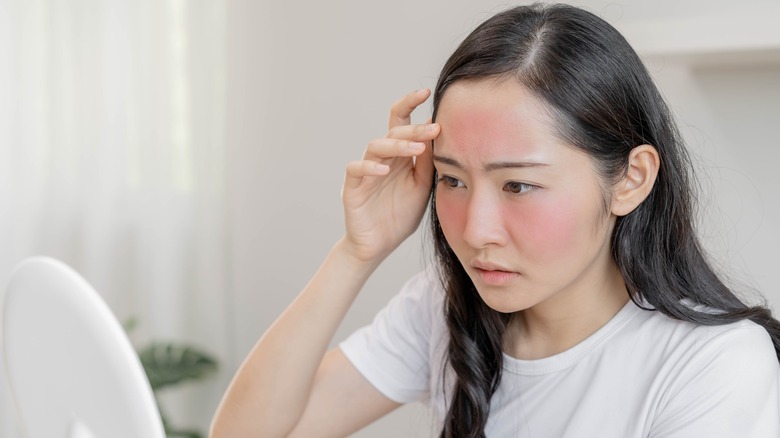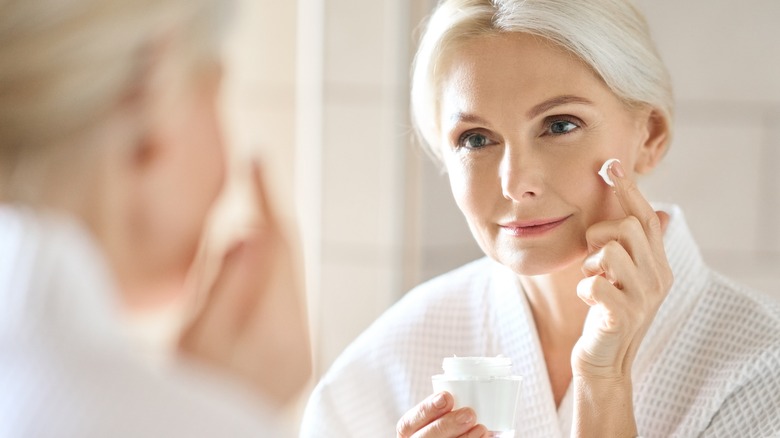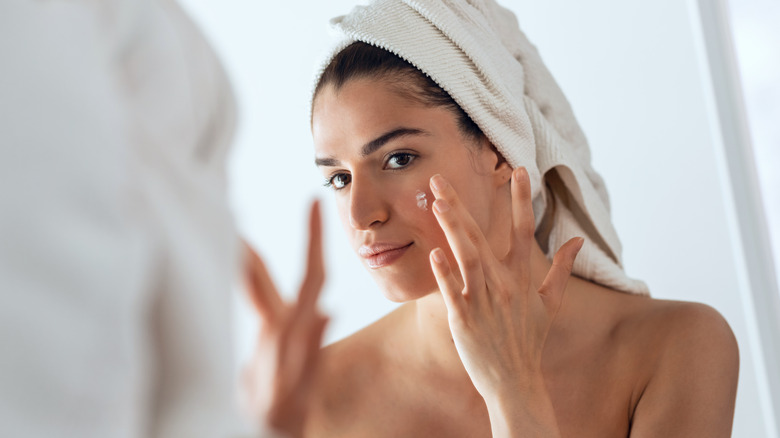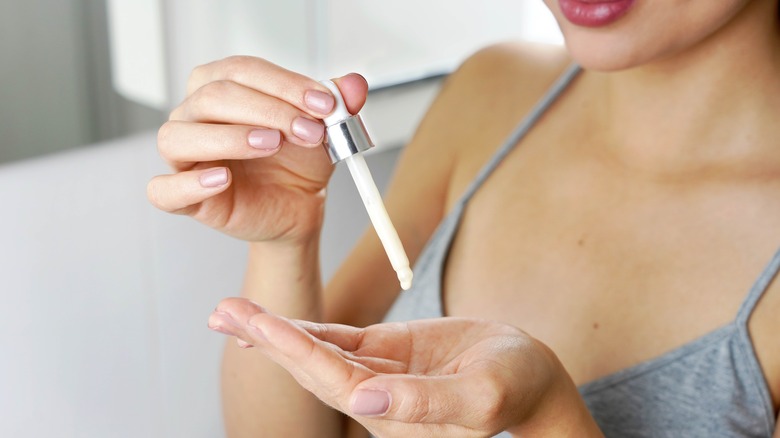The Acid Almanac: Your Guide To The Skincare Staple (Because There's A Lot Of Them)
Acids, in their various forms, are one of the most popular beauty products around. Of these skincare wonders, there are three main types most acids fall into — AHAs, BHAs, and PHAs. We've got a whole section on PHAs (polyhydroxy acids) below, so we'll skip straight to the main two. AHAs are short for alpha-hydroxy acids and are a class of organic compounds often derived from plants and fruits. Examples include lactic, citric, and glycolic acid (which can really benefit your beauty routine). Their main function is to exfoliate the skin, which can have various benefits, from softening wrinkles to acne control.
How AHAs do this isn't fully understood, but pharmaceutical studies suggest they weaken the bonds of dead skin cells on the skin, helping with rejuvenation (per Imperial Bioscience Review). BHAs, or beta-hydroxy acids, are thought to have similar effects on the skin. However, because of their higher level of solubility, they can penetrate deeper.
This makes BHAs, such as salicylic acid, a good choice for treating acne. As dermatologist Dr. Dray explains, BHAs will be best for oily skin, which is often more acne prone, whereas AHAs will be more appropriate for dry skin types since they aren't as penetrating, so won't dry out the skin as much. For sensitive skin, there are some AHA options, but PHAs may be a better choice.
Citric acid for brightening dull skin
Citric acid is an AHA that's been in use for many years. As you might've guessed, it comes from citrus fruits and plays an active role in the skin rejuvenation process. Like other AHAs, citric acid is water soluble. This means it can enter the upper layer of the skin (called the epidermis) but can't go any further. The epidermis is where dead skin cells settle. Citric acid and other AHAs dissolve the bonds of the dead skin cells, allowing fresh skin to reach the surface.
For skin brightening, in particular, research shows that citric acid also affects the brightness of skin through its interaction with melanin, the substance responsible for our skin's pigmentation (per the Journal of Cosmetic Dermatology). Scientists have shown that fruit acids like citric acid inhibit the production of melanin, which in turn makes the skin appear brighter.
Another factor that might explain why citric acid makes the skin appear brighter and more refreshed is that it also contributes to the protection of the skin's barrier. The skin's barrier is what protects the skin against external irritants and retains moisture, and when it's damaged, it can cause wrinkling and dry skin. In older studies, citric acid has been shown to thicken and strengthen this barrier, which can maintain healthy and bright-looking skin (Dermatological Surgery Journal).
Ferulic acid for hyperpigmentation
Ferulic acid is another AHA derived from grains, fruits, and vegetables. Interestingly, although most AHAs generally increase photosensitivity, meaning your skin can get burnt easier when using them, ferulic acid has some resistance against UV damage because it's an antioxidant. Antioxidants, as we'll explain, are strong combatants against harmful molecules brought about by sun damage. In fact, when you combine ferulic acid with other antioxidants such as vitamin E, its UV protection efficacy can increase four to eight-fold, though we would still advise keeping SPF on hand if you do suffer from pigmentation (according to the Skin Aging Handbook).
Sun damage itself, as you might know, is one of the key components of hyperpigmentation, which is when the skin produces too much melanin, clumping together in certain areas and creating an uneven skin tone. Ferulic acid, as well as offering some protection against this damage, can also help to treat pigmentation after the fact.
As explained in a study, ferulic acid can reduce melanin buildup significantly, as well as other factors that may play a role in hyperpigmentation, such as sunburn and skin dehydration. To boot, it can even minimize the visible effects of photoaging (aka sun damage), improving skin hydration and elasticity, helping to give you not only a more even skin tone but firmer and tighter skin (per the Journal of Dermatologic Therapy).
Glycolic acid is a good choice for oily skin
Glycolic acid is an AHA that you may see in a lot of skincare products. It was originally derived from sugar cane, and like the others on our list, it's a strong (perhaps the strongest) exfoliating agent. It's actually one of the smallest AHAs in terms of molecule size, which means that it has greater penetrating power than the others (as explained in Scientific Reports). This is what makes it a great partner in treating oily and acne-prone skin.
Oily skin is caused by the excessive production of oily secretions from the hair follicles, i.e., your pores. Oil secretion varies from person to person, stemming from various causes such as genetics, hormones, or environment (per the Journal of Clinical Aesthetic Dermatology). While this skin type isn't necessarily a bad thing, excess oil can lead to the proliferation of bacteria called cutibacterium acnes on the skin surface and within the follicles, causing spots as well as other health issues.
Glycolic acid not only inhibits this type of bacteria but can also target oily skin issues at a base level by unclogging blocked pores and reducing the appearance of acne. This is because, as we hinted, glycolic acid is highly permeable, meaning that it can disrupt bacterial cells and reduce inflammation at the same time.
Kojic acid can help with uneven skin tone
Another AHA, kojic acid, comes from the fermentation of products such as rice wine and soy sauce, as well as specific fungi, including aspergillus and penicillium. One of the reasons this acid has become so popular, specifically for issues like uneven skin tone, is because it's effective in reducing the build-up of melanin. As we've discussed, melanin gives our skin pigment. However, excess melanin production can cause uneven skin tone issues such as hyperpigmentation, including melasma.
Melasma, according to DermNet, is a common skin disorder where dark patches can appear on the face. This could be due to sun exposure, but also other factors such as hormones and genetics. Kojic acid can help fight the production of excess pigmentation by inhibiting the activity of an enzyme called tyrosinase, which is involved in the production of melanin.
Research explains how kojic acid can reduce the production of melanin and help address pigmentation issues (per the Biomedicine and Pharmacotherapy Journal). In addition to this, kojic acid helps with sun protection because of its UV filtering properties, making it a great all-around choice for uneven skin.
Lactic acid is best for sensitive skin
Lactic acid is a skincare product that's been around since the time of the ancient Egyptians when they used soured milk as a way to restore youthfulness and gain radiant skin. Though they may not have known why this was so effective at the time, it's likely that since milk has a high concentration of lactic acid, they were performing their version of AHA skin care.
Lactic acid has many benefits, especially for those with sensitive skin. Sensitive skin refers to skin that is easily irritated or prone to adverse reactions when exposed to certain substances or environmental factors (per DermaNet). It can manifest as redness, itching, dryness, or a burning sensation.
Research points out that lactic acid acts as a pH regulator, helping to maintain the skin's natural balance, as well as having moisturizing properties, which can help hydrate the skin (per the Journal of Chemical and Pharmaceutical Research). Lactic acid is also known to have antimicrobial activity, which can be beneficial for individuals with sensitive skin that is prone to acne or other bacterial infections.
It's still an exfoliant like other AHAs, helping to remove dead skin and rejuvenate, but it's milder than most other acids. As such, it may take longer to see results with this product, but in turn, you shouldn't experience as much irritation or redness, making it ideal for sensitive skin types.
Malic acid for reducing fine lines
Malic acid is an AHA that occurs naturally in fruit. It has a low pH, making it useful in the food industry. But of course, one of its more popular uses is for skin care. Like other AHAs, malic acid has an exfoliating effect, but interestingly, research suggests it also has some moisturizing and antibacterial properties, which make it a good choice for dry or combination skin (per the Journal of Molecules).
Moreover, since recent investigations now suggest that inflammation may play a key role in the aging process, this is another area where malic acid can be helpful. As we age, our bodies are less able to carry out tissue repair, which is crucial to overall skin health, resulting in chronic, low-grade inflammation that damages cell tissues even further (explained in the Federation of European Biochemical Societies Journal). Malic acid has been found to infiltrate immune cells in the dermis, which suppresses this inflammatory response (according to the Immunopharmacology and Immunotoxicology Journal).
This is important because the damage that inflammation causes can prevent the skin from carrying out work like cell turnover and protection, exacerbating dry skin and fine line development. Luckily, as dermatologist Julie Russak explains to NewBeauty, although it's on the milder side, malic acid can promote skin cell turnover, which can help to fight common signs of aging such as wrinkles and fine lines, without doing as much damage as other, stronger AHAs.
Choose oleic acid for dry skin
Oleic acid, also known as omega-9, is derived from plant and vegetable fat and is one of the most abundant fatty acids in nature. Many consider oleic acid an AHA, but if you look at the chemical structure of this acid, that's not quite true. While oleic acid has a similar chemistry to AHAs in that both are carboxylic acids, it doesn't have the right structure to be considered an AHA (for the chemists among you, it hasn't got the additional hydroxyl group characteristic of an AHA). This means it doesn't have an exfoliating effect, but it does have some great benefits for dry skin.
There are many factors in dry skin, but one of the most significant issues is damage to the skin's barrier. This can happen due to sun exposure and environmental damage, and the subsequent inflammation — oleic acid helps facilitate wound healing and suppress this inflammation.
In research, the topical application of oleic acid has been shown to restore connective tissue, preventing scarring and helping to deposit collagen, which can help to maintain the skin's barrier (per the Journal of Drug Delivery and Translational Research). Moreover, it can help to reduce the barrier damage which comes from UV exposure, by stopping inflammatory substances from entering damaged cells, thus stopping many of the factors involved in developing dry skin (according to the Inflammopharmacology Journal).
For a milder alternative to AHAs, try PHAs
While AHAs can be suitable for some people with mild skin sensitivity, people with particularly irritable skin might want to consider PHAs. Some PHAs include lactobionic, galactose, gluconolactone, or gluconic acid. PHAs, short for polyhydroxy acids, contain multiple hydroxyl acid compounds.
This makes them quite dense, so they don't penetrate the skin as deeply as AHAs and BHAs, perhaps explaining why they're thought to be less irritating. They still have an exfoliating effect, but they also have a moisturizing quality which allows them to gently reduce dead skin cells without some of the flare-ups you might see with other acids (per Cosmeceuticals).
Due to these characteristics, PHAs can be helpful for many skincare issues, such as rosacea, hyperpigmentation, and overall skin texture, explains Dr. Dray. Interestingly, there's also research that suggests that people who use PHAs experience less sun damage than those who use AHAs, which might be useful for those with dry as well as sensitive skin (according to the International Journal of Dermatology). However, for those with oily skin and acne, they might not be quite as effective as an AHA or BHA.
Retinoic acid, the all-round wonder
Retinoic acid is an active form of retinol and a vitamin A derivative. It's not in the hydroxy acid family, so it's not classed as an AHA, though they do share some similar features — both having a hydroxyl acid group (i.e., an oxygen and hydrogen group) and helping with skin cell turnover. However, unlike AHAs, retinoic acid and its derivatives aren't exfoliators — at least not in the same way as AHAs.
Studies show that retinoic acid loosens the bonds between dead and healthy skin cells, but doesn't break or dissolve them like AHAs (per the Journal Advances in Dermatology and Allergology). This increases cell turnover. As retinoic acid is able to penetrate deep into skin tissue, it also helps in creating new proteins such as collagen, which are crucial in maintaining a healthy skin barrier, simultaneously protecting against skin irritants and improving the elasticity and firmness of the skin.
Research shows these factors can reduce the visible signs of aging, such as fine lines and wrinkles, which occur when the skin barrier is damaged (per the Journal of Drugs in Dermatology). But they also show it can be an effective means of acne control by helping to reduce pore size, a factor in excess sebum production, which is one of the main contributors to acne. Since retinol is an active product, however, you should be careful when using it on dry or sensitive skin. Apply sunscreen and moisturizer after use to avoid irritation.
Salicylic acid remains the leader for acne treatment
Salicylic acid is one of the classic examples of a BHA, although technically, it should really be in its own category since it has a slightly different structure than either BHA or AHAs (per the Imperial Bioscience Review). The way it works, though, is on par with other BHAs. It can penetrate on a deeper level than AHAs because it's lipophilic, meaning fat-soluble.
And like other BHAs, it's very effective in treating acne because it reduces inflammation and helps to get rid of dead skin cells. This is important because one of the major components of acne formation is that sebum and dead skin cells end up blocking pores, leading to breakouts (as described by the National Health Institute). Normally, sebum is present to keep the skin from drying out and can circulate the pores without issues. However, for acne sufferers, it gets stuck together with the dead cells of the outer layer of the skin (known as dead keratinocytes), causing clogging and the growth of bacteria. This, in turn, creates redness, swelling, and inflammation.
Salicylic acid can make the outermost layer of the skin softer and dissolve connections between skin cells. This decreases the adhesion between cells and allows the shedding of the top layer of skin cells, unclogging pores and promoting the turnover of skin cells — overall, making it an excellent acne remedy (according to the Journal of Experimental Dermatology).
Tartaric acid as an antioxidant aid
Tartaric acid is an AHA with strong antioxidant properties. For the uninitiated, antioxidants play a key role in many of the functions crucial to skin health. They work by neutralizing free radicals, a type of unstable molecule, preventing them from causing damage to cells. When free radicals accumulate — usually due to sun exposure, pollution, or metabolic factors, they can contribute to oxidative stress, which can lead to tissue damage and various skin issues.
As an antioxidant, tartaric acid helps to combat the buildup of free radicals, but it also plays another role in protecting the skin's barrier. Research shows that, along with other AHAs, tartaric acid can help the skin to retain moisture whilst exfoliating and removing unhealthy cells (per the International Journal of Cosmetic Science).
Together, these factors can improve the appearance of acne and sun-damaged skin. But it's not for everyone — and although tartaric acid can help in mediating the effects of sun exposure, it's not a substitute for your daily sunscreen. Like other AHAs, those with sensitive skin should apply with caution or under supervision from a dermatologist.


